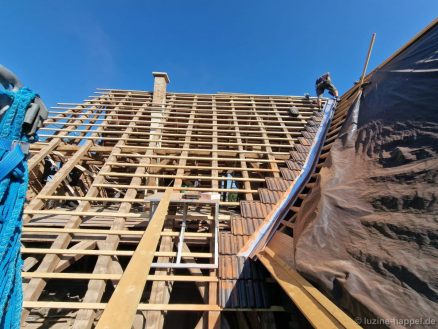At the invitation of the Schmidt family, the owners, the Wanfried embroidery circle was – among many others – on the day of the open monument at the Aue manor involved in the “Adventure Monument”. Both the intangible cultural heritage of Schwalm whitework and the listed building are traditional cultural assets that should be preserved for posterity.
Participation was also a real adventure for us embroiderers.
In order to direct the expected flow of visitors, we planned a one-way path. Therefore, during the preview we chose a large room that can be entered in the right corner

and a smaller room to the left,

through which visitors could leave our exhibition.

When we arrived to set up the exhibition, the picture had changed,
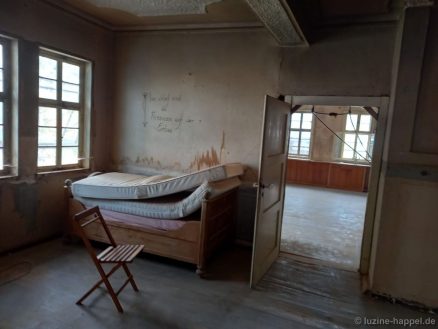
because shortly before the craftsmen had discovered major damage. The small room was now missing the left wall

and the wall with the door.

Instead there were supports and there was a large hole in the ceiling.

A ramp was built to prevent visitors from tripping over the beam.
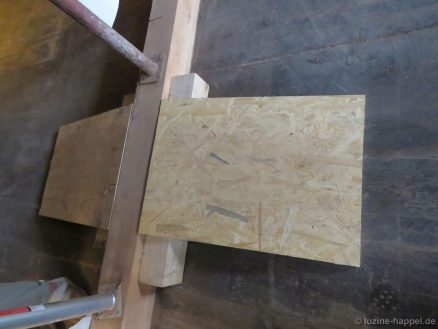
The rubble had been cleared away and the floor cleaned.

All that remained was to clean a few windows, remove clay dust from the available furniture and remove the cobwebs from the corners.

Large cloths attached with clips to clotheslines that we had brought with us separated our exhibition area.

Then tables, stools, folding chairs and baskets full of other equipment were brought in. We received power via an unrolled cable drum. Unfortunately, it wasn’t strong enough for the iron – so the textiles couldn’t be finally smoothed again. But it provided enough light for embroidery and good lighting for the exhibits.
Should the clay plaster on the walls be covered in a more rustic style with the sackcloth we brought with us or with coloured cloths?

How should the tables be arranged?
After a few tests and short discussions, the basic concept was in place and the decoration could begin.

On the bed was the magnificent,

completely individually designed
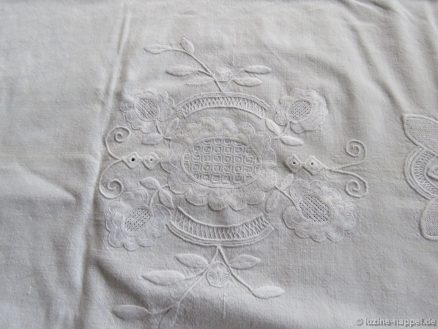
Wedding tablecloth spread.

It was created with a matching pillow in more than 400 hours of embroidery on the finest linen.

Now we have to set up a few stools so that tired visitors don’t want to use the bed to rest. (It couldn’t be completely prevented.)

The covered supports were decorated with tablecloths.

Curtains were attached. Pillows draped.

Teacloths

lamps and runners,

doilies and table bands,

pictures and everything else brought along

were laid out.

A final check after the work was done made the exhausted women happy – Sunday can come!

On the morning of the day of the open monument, the manor is still almost sleepy.

That should change very soon.
Streams of visitors began

and didn’t let up until evening. Some had come from far away. Guests even came from the Harz Mountains.

Crowds of curious people also pushed their way through “our” rooms. Many of the visitors took a closer look at the whitework,
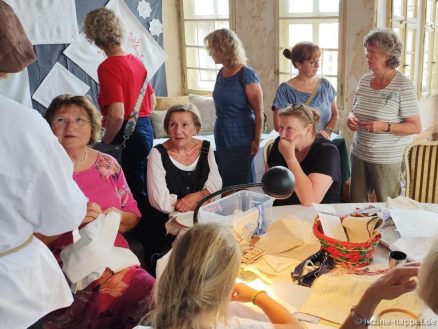
sought conversation and “looked over the embroiderers’ shoulders” or tried out a few stitches themselves.

A total of three younger women want to learn the technique and be there at the next embroidery circle meeting.
We were particularly enthusiastic about three girls around 10 years old who asked to be allowed to embroider too. Highly concentrated, skillful and with great perseverance, they learned several stitches that day.

A very pleasing result and an encouragement for the future, with which our efforts were rewarded.
We would like to thank the Schmidt family for the invitation and for making the presentation possible.

The HR television team has a Video, which is available until October 8th, 2024.
Shortly before the end, a passage from us is shown:

In addition, our regional newspaper reported in detail.



















































